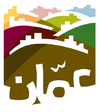Amman
| Amman عمّان ʿAmmān |
|||
|---|---|---|---|
| — City — | |||
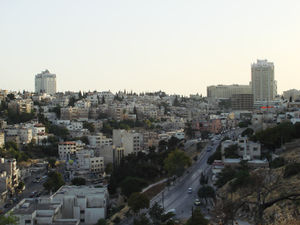 |
|||
|
|||
| Nickname(s): The City of seven hills, Philadelphia (Ancient Greek), Ammon, Rabbah(Ammonite) | |||
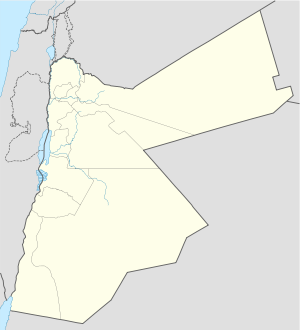 Amman
|
|||
| Coordinates: | |||
| Country | |||
| Governorate | Capital Governorate | ||
| Founded | 7000 B.C. | ||
| Municipality | 1909 | ||
| Government | |||
| - Mayor | Omar Maani | ||
| Area | |||
| - Total | 1,680 km2 (648.7 sq mi) | ||
| - Land | 700 km2 (270.3 sq mi) | ||
| Elevation | 777m-1,400 m (2,564 ft) | ||
| Population (2005)[1] | |||
| - Total | 1,919,000 | ||
| Website | http://www.ammancity.gov.jo | ||
| 1. Population refers to Greater Amman | |||
Amman (pronounced /ɑːˈmɑːn/; Arabic: عمّان, ʿAmmān) is the capital and largest city of the Hashemite Kingdom of Jordan. A city of about 2 million inhabitants (2008 estimate),[2] it is the country's political, cultural and commercial centre and one of the oldest continuously inhabited cities in the world.[3] Amman is the administrative seat of the homonymous governorate.
Contents |
History

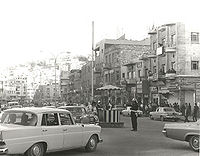
During its long history, Amman has been inhabited by several civilizations. The first civilization on record is during the Neolithic period, around 8500 BC, when archaeological discoveries in 'Ain Ghazal, located in eastern Amman, showed evidence of not only a settled life but also the growth of artistic work, which suggests that a well-developed civilization inhabited the city at that time. In the 13th century BC Amman was called Rabbath Ammon or Rabat Amon by the Ammonites. In the Hebrew Bible, it is referred to as Rabbat ʿAmmon (Tiberian Hebrew Rabbaṯ ʿAmmôn). It was later conquered by the Assyrians, followed by the Persians, and then the Greeks. Ptolemy II Philadelphus, the Hellenic ruler of Egypt, renamed it Philadelphia. The city became part of the Nabataean kingdom until 106 AD when Philadelphia came under Roman control and joined the Decapolis.
In 326 AD, Christianity became the religion of the empire and Philadelphia became the seat of a bishopric during the beginning of the Byzantine era. One of the churches of this period can be seen on the city's Citadel.
Philadelphia was renamed Amman during the Ghassanian era, and flourished under the Caliphates (with nearby capital) of the Umayyads (in Damascus) and the Abbasids (in Baghdad). It was then destroyed by several earthquakes and natural disasters and remained a small village and a pile of ruins until the Circassians settlement in 1887. The tide changed when the Ottoman Sultan decided to build the Hejaz railway, linking Damascus and Medina, facilitating both the annual hajj pilgrimage and permanent trade, putting Amman, a major station, back on the commercial map.
In 1921, Abdullah I chose Amman instead of Samhal as seat of government for his newly-created state, the Emirate of Transjordan, and later as the capital of the Hashemite Kingdom of Jordan. As there was no palatial building, he started his reign from the station, with his office in a train car. Amman remained a small city until 1948,and 1967, when the population expanded considerably due to an influx of Palestinian refugees from what is now Occupied Territories. Amman has experienced exceptionally rapid development since 1952 under the leadership of two Hashemite Kings, Hussein of Jordan and Abdullah II of Jordan.
In 1970, Amman was the site of major clashes between the Palestine Liberation Organization (PLO) and the Jordanian army. Everything around the Royal Palace sustained heavy damage from shelling. Most of Amman suffered great damage from PLO rockets and the Jordanian army's shells.
The city's population continues to expand at a dizzying pace (fueled by refugees escaping the wartime events in the West Bank and Iraq). The city received refugees from these countries on a number of occasions. The first wave of Palestinian refugees arrived from Palestine in 1948. A second wave after the Six-Day War in 1967. A third wave of Palestinian and Jordanian and Southeast Asians, working as domestic workers, refugees arrived in Amman from Kuwait after the Gulf War of 1991. The first wave of Iraqi refugees settled in the city after the first Gulf War, with a second wave also arriving after the 2003 invasion of Iraq. During the last 10 years the number of new buildings within the city has increased dramatically with new districts of the city being founded at a very rapid pace (particularly so in West Amman), straining the very scarce water supplies of Jordan as a whole, and exposing Amman to the hazards of rapid expansion in the absence of careful municipal planning.
On November 9, 2005, coordinated explosions rocked three hotels in Amman, resulting in the death of 60 people and the injury of 115 others. Al-Qaeda claimed responsibility for the act, which was carried out despite the fact that the birthplace of since-killed Al Qaeda terrorist leader Abu Musab al-Zarqawi, is the town of Zarqa, less than 30 km (19 mi) from Amman. The sheer brutality of the attacks, which targeted, amongst other things, a wedding party being held at one of the hotels, caused widespread revulsion across the widest range of Jordanians. Large protests and vigils followed in the wake of the attacks.
Geography

Amman is located in a hilly area of north-western Jordan. The city was originally built on seven hills, but it now spans over an area of nineteen hills (each known as a Jabal, Tàl, Mount or Mountain). The main areas of Amman gain their names from the hills and mountains on whose slopes they lie. The city's elevation ranges from mountain to mountain, they range from 780m-1400m (2600–4600 feet). The elevation can be clearly seen in the city's streets, as many of the roads are very steep to the point where the accompanying sidewalks are turned into stairs.
Climate
Amman's location and altitude affects its climate severely, Spring is brief, mild and lasts a little less than a month, from April to May, with rain during the morning and the afternoons, high temperatures are around 14 °C (57 °F) and lows are a little less than 7 °C (45 °F) and several times going near 0 °C (32 °F) causing several freezes. Snow has been know to fall mildly at the city during the Spring, sometimes with severe storms rarely happening during the season. Amman has long summers starting from late May to early October. Summer's high temperatures range from 25 °C (77 °F) to 33 °C (91 °F), usually with very low humidity and frequent cool breezes, most Summers are rain-free with cloudless skies during the noon period. There have been several occasions when it rained before fog covered the city during the cold summer nights that the city is known for. Autumn is usually mild, and lasts from October to Late November or mid-December. It can range from being very rainy and possibly snowy to arid dry, there has been several cases when the season has combined with the Summer and even brought dusty winds that rarely if ever occur during the hottest summers, example being the Autumn of 2005, which had no rain whatsoever. In several other occasions, Autumn combined with the winter and served creating a prolonged cold winter. The winter season of Amman is cold and long, usually starting from late November to mid-April, it sees temperatures frequently near or lower than 0 °C (32 °F), and snow usually falls a few times each year. Winter in Amman is usually one of the coldest in any major city in the extreme of south eastern Europe (Eurasia) and the surrounding countries due to the very high elevation of the city, winters are usually rainy and many rain storms occur around the winter, few of them accompanied by moderate to severe lightning storms, after a rainy afternoon with temperatures around 4 °C (39 °F) the night temperatures fall below 0 °C (32 °F) freezing any rain that accumulated, sleet is very common and the dew in the dry winter mornings is usually found frozen until 10 AM. Snowy winter storms occur several times around the city, but the severe industrialized atmosphere raises the temperature of the city around 4 °C (39 °F) making the snow milder in the center of the very busy downtown areas, alas allowing the snow accumulation in the suburbs and the surrounding areas to be much heavier. At least one severe snow storm every couple of years will accumulate up to 15 or 20 inches of snow in the busiest sections of the city. The weather in Amman is highly unpredictable, especially in the winter, it's common to observe a very pleasant and sunny morning, and a cold snowy or rainy afternoon, or vice versa. Temperatures are known to drop or rise suddenly, Fog can sometimes cover the entire city for days, even weeks and lightning storms, although infrequent, can happen out of nowhere. The summer's pleasant temperatures can be disturbed by heatwaves that suddenly raise the city's temperatures to around 36 °C (97 °F) and in some rare but recorded cases to be as high as 41 °C (106 °F) such as the summer of 1999. A much more common weather inconvenience is the sudden drop in temperatures which occurs during many summer nights accompanied by moderate winds and in some cases smog.
| Amman | ||||||||||||||||||||||||||||||||||||||||||||||||||||||||||||
|---|---|---|---|---|---|---|---|---|---|---|---|---|---|---|---|---|---|---|---|---|---|---|---|---|---|---|---|---|---|---|---|---|---|---|---|---|---|---|---|---|---|---|---|---|---|---|---|---|---|---|---|---|---|---|---|---|---|---|---|---|
| Climate chart () | ||||||||||||||||||||||||||||||||||||||||||||||||||||||||||||
|
||||||||||||||||||||||||||||||||||||||||||||||||||||||||||||
|
||||||||||||||||||||||||||||||||||||||||||||||||||||||||||||
| Climate data for Amman (1976-2005) | |||||||||||||
|---|---|---|---|---|---|---|---|---|---|---|---|---|---|
| Month | Jan | Feb | Mar | Apr | May | Jun | Jul | Aug | Sep | Oct | Nov | Dec | Year |
| Average high °C (°F) | 12.2 (54) |
13.5 (56.3) |
17.0 (62.6) |
22.7 (72.9) |
27.6 (81.7) |
30.5 (86.9) |
32.1 (89.8) |
32.1 (89.8) |
30.5 (86.9) |
26.5 (79.7) |
19.7 (67.5) |
14.2 (57.6) |
23.2 (73.8) |
| Average low °C (°F) | 3.9 (39) |
4.5 (40.1) |
6.6 (43.9) |
10.2 (50.4) |
14.2 (57.6) |
17.5 (63.5) |
19.7 (67.5) |
19.4 (66.9) |
17.6 (63.7) |
14.5 (58.1) |
9.3 (48.7) |
5.5 (41.9) |
11.9 (53.4) |
| Rainfall mm (inches) | 60.0 (2.362) |
58.5 (2.303) |
44.0 (1.732) |
8.3 (0.327) |
2.8 (0.11) |
0.1 (0.004) |
0.0 (0) |
0.0 (0) |
0.1 (0.004) |
8.3 (0.327) |
26.2 (1.031) |
50.0 (1.969) |
258.3 (10.169) |
| Source: [4] | |||||||||||||

Districts
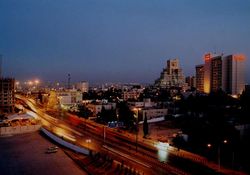
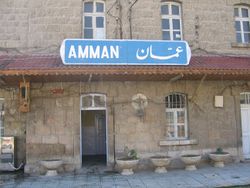
The following is a list of districts that make up the Greater Amman Municipality (GAM):[5]
| District Name | |
|---|---|
| 1 | Abdali |
| 2 | Abu Nseïr |
| 3 | Um-Othaïna |
| 4 | Qwéismé, Jwaïde, Abu Âlanda and Raqim |
| 5 | Yarmuk |
| 6 | Jizah |
| 7 | Müwaqar |
| 8 | Mqabalaïn |
| 9 | Badr |
| 10 | Badr'è Jadida |
| 11 | Basman |
| 12 | Husban |
| 13 | Jbeïha |
| 14 | Khraibet'è Suq |
| 15 | Marj'l Hamam |
| 16 | Marka |
| 17 | Medina |
| 18 | Nawur (Na'ûr) |
| 19 | Ohod |
| 20 | Ras'l Êyn |
| 21 | Sahab |
| 22 | Shafa Badran |
| 23 | Sweïleh |
| 24 | Tariq |
| 25 | Tla’l Ali |
| 26 | Valley of Orchards |
| 27 | Zahran |
Transportation
The city's largest airport, Queen Alia International Airport, situated about 30 minutes south of Amman, is the major international airport for Jordan and the hub for Royal Jordanian, the flag carrier. The airport has three terminals, two passenger and one cargo, and in 2007 handled between 4 to 5 million passengers. The airport is undergoing expansion, including a new terminal costing $700M, that will allow the airport to handle over 9 million passengers. A new rail line being constructed will connect Queen Alia International with Raghadan, Mahatta, and Zarqa. Taxis and buses serve the airport 24/7.
.jpg)
Marka International Airport is a one-terminal airport that serves primarily domestic and nearby international routes and the military.
The recently constructed Abdoun Bridge spans Wadi Abdoun, and connects the 4th Circle to Abdoun Circle. It is considered one of Amman's many landmarks. It is the first curved suspended bridge to be built.
The Hejaz railway, built in the early 20th century, was used primarily for pilgrims to reach the holy cities of Mecca and Medina, but now the rail line is basically used by tourists. There are new projects that are being built to add more railines in the Kingdom, most of which will go through Amman.
Currently under construction, dedicated lanes for bus lines will serve as part of the new urban rapid transit. There are plans to construct three line metro system in Amman. The first phase is two lines, red and green, connecting East, Central, and West Amman with one transit station at Amman Plaza with some connections to the Northern and Southern suburbs. The second phase consists of a yellow line connecting North and South Amman with transit to the red and green lines at Abdali and City Hall. The project would cost more than half a billion dollars. There are also plans to construct funicular line in East Amman connecting the old downtown with Jabal al' Qalaat. These projects should be completed by 2016 with the entire capital transportation system completed by 2025.
Amman will be connected by the Kingdom's national rail project that will link Amman with the rest of the Kingdom and the region. It should be completed by 2013.
Amman has an extensive highway system that links every part of the city to one another. Its highways also link nearby cities such as Zarqa and Madaba. The Amman-Zarqa highway becomes very congested with commuters at rush hour which is why a new commuter rail line is being constructed. Amman also has an extensive bus system. There are pedestrian tunnels that bring pedestrians from one side of a highway to another.
There are eight circles, or roundabouts, that span and connect West Amman. However, the city lacks an operable rail or metro system which causes severe congestion, especially in old Amman, where its narrow streets cannot handle many people. To add to the congestion, all the Kingdom's highways pass through Amman, further increasing traffic in the capital. Drivers in Amman are very defensive and are known for acting irresponsibly, cars rarely stay in their lanes and driving very fast in narrow roads and other inappropriate places is a characteristic of the Jordanian driver, during many nights illegal drifting competitions happen in the suburbs around and after 3am, causing loud noises but with little records of accidents. Cars' movement in the suburban and residential areas' streets become much lighter after 2AM but continue 24 hours a day, while highways always have a large number of cars 24/7 with congestion around 5PM to 8PM. Even suburban and residential roads are known for having a non-stop car flow during the day and most hours of the night.
By land, the city has frequent bus connections to other cities in Jordan, as well as to major cities in neighboring countries; the latter are also served by service taxis. Internal transport is served by a number of bus routes and taxis. Service taxis, which most often operate on fixed routes, are readily available and inexpensive. The two main bus and taxi stations are Abdali (near the King Abdullah Mosque, the Parliament and Palace of Justice) and the newly built Raghadan Central Bus Station (near the Roman Amphitheater in downtown). The city can suffer from considerable traffic congestion at peak hours, especially during summer months when affluent vacationers from the Persian Gulf region summer in Amman to take advantage of its relatively mild weather.
Economy
.jpg)
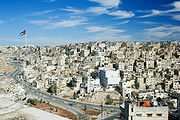
Amman is a regional hub in communications, transportation, medical tourism, education, and investment. Amman is aggressively positioning itself as a hub for business, and new projects are continually transforming the city's skyline. Following the 2003 Iraq War, all business dealings with Iraq flow through Amman in some way. Its airport, Queen Alia International Airport, is the hub of the national carrier, Royal Jordanian, which is a major airline in the region.[6] The airline is headquartered in central Amman.[7] Amman is a major tourist gateway in the country because most of the country's foreign tourists arrive in Jordan through Amman. Amman is currently experiencing rapid growth in many different areas, with large growth seen in the real estate, construction, banking, finance and business sectors. Numerous skyscrapers are under construction as the city municipality recently lifted the ban of buildings taller than 4 stories and allocated designated areas for high rises. All major highways of Jordan cross in Amman making the capital busy with freight trucks, buses and cars passing through the city.
Amman is already being called "the new Beirut" and business capital of the Levant. Construction projects like the Abdali Urban Regeneration Project, the Jordan Gate Towers and TAJ Mall will just solidify Amman's claim to this title. With Jordan becoming known as the gateway to Iraq and the Palestinian territories and for its free trade policies, Amman has the potential to monopolize business and trade in the Levant.
The Greater Amman Munincipality's heavy investment in its infrastructure, like the expansion of Queen Alia International Airport, the construction of a state of the art public transportation system, a national railway, and expansion of road works, will ease the arrival of millions of new visitors and tonnes of cargo through this soon to be regional hub. Amman's increasing importance to the reconstruction of Iraq and the developing economy of the Palestinian territories make these investments unavoidable.
Amman has both a modern and historic touch. East Amman is the older part of the capital where single family dwellings on the hill side and small shops and bazaars in the wadis, or valleys, dominate East Amman's layout. Old Amman is filled with souks, or bazaars, small shops, and single family dwellings all.
Several industrial cities are being developed near Amman, most important being Al-Mushatta, poised at turning this once sleepy village into a global economic powerhouse.
West Amman, however, is less densely populated and more scenic. It is also the more prosperous part of Amman, with much of the city's economic activity being centered in West Amman. Parks and wide boulevards with towering apartments and office buildings dominate the scenery. Most of the city's 5-star and 4-star hotels are located in West Amman. Important districts include Shmeisani and Abdali, the main economic centers of Amman, Abdoun, the up-scale residential district, and Jabal Amman, one of Amman's historic districts. A large contrast exists between the more affluent districts of West Amman and the more middle and working class districts of East Amman.
Amman has a very large expatriate population because of its reputation as a haven for refugees seeking political asylum. Iraqis, Palestinians, Lebanese, and Armenians are among the many different expatriate populations currently residing in Amman. Egyptians, Syrians, and South East Asians also reside in vast numbers that work as domestic or civil servants. Many Westerners currently reside in Amman as many international organizations and diplomatic missions have regional offices in Amman.
New projects and proposals in and around the city include:
- TAJ Mall is envisioned to primarily be an upscale retail and lifestyle development consisting of a multi purpose facility catering tor a wide spectrum of tenants with the main objective of entertaining answering clients through a pioneering approach and diversified services including cinemas, advanced arcade centers, retail outlets, food courts, kids zones, restaurants and cafes in addition to retail stores and a large supermarket. With the investment of more than 130 million Jordanian Dinars Taj Mall will be Jordan’s newest development combining a unique blend of architectural design and innovative facilities. Taj Mall is designed by the world known American F+A design consultants which has a recognizable portfolio in the USA and the Arab World, such as the Fashion Island California and Mall of the Emirates.
- The Abdali Downtown project: this new development in the heart of Amman is among the largest projects under construction in the kingdom, and is a mixed-use development consisting of retail, outdoor shopping and restaurants, residential and office buildings. The master plan includes a large public green park, along with an outdoor pedestrian strip.[8] The first phase of the project is expected to be completed by 2010.
- The construction of the American University of Jordan.
- The construction of the Jordan Gate Towers near the 6th Circle, which is nearly completed, is being funded by Bahraini and Kuwaiti entrepreneurs. The two identical skyscrapers will house office buildings and a five star hotel.
- Bonyan city, which will consist of 5 new skyscrapers that will house apartments and offices
- The Heights Tower, consisting of 35 floors, will house apartments and it is currently under construction.
- Sky Tower, a residential tower consisting of 30 floors, is under construction.
- Amman Financial Tower, consisting of 56 floors, has been approved for construction.
- Betina City consists of 3 central skyscrapers, a mega-mall, a suspended river, and 3 additional towers.
- Sanaya Amman, two identical 65 floor buildings connected by a pedestrian walkway that will house the world's highest swimming pool. This residential twin tower project will be built in Abdoun by Limitless.
- The Abdoun suspended bridge, which spans Wadi Abdoun. This recently completed project reduces congestion in Wadi Abdoun and creates a new highway link between West and South Amman.
- The $700 million expansion of Queen Alia International Airport increasing capacity from 3.5 million to 9 million in the first phase and 12 million in the second phase.
- Multi-billion dollar Wadi Amman Regeneration Project. This project will completely revamp the old downtown and restore it to its previous prominence. It will also revitalize the entire area by attracting affluent Ammanis to settle and shop here.
- The Jordan Twin Towers, which are to be constructed by the Nuqul Group, and will be 34 stories high. Expected to be complete by 2008.
- Al Andalucia, being constructed near Amman. This project will include over 600 villas, and consists of many facilities such as spas, fitness and health centers, swimming pools, and a recreation area to be completed by 2008. 64% of the village have already been sold.
- A proposed Amman World Trade Center, which will consist of 33 floors.
- Amman Gardens which is a high-end residential suburb
- Ahl al Azm, a $1 billion city near Queen Alia International Airport, will be built in several phases with a total of about 16,000 residential units and 800 offices. The city will be connected by rail to Amman. The residential city will mostly be inhabited by low and middle income families.
- A massive new Royal Jordanian headquarters
These projects, along with the boom in the Jordanian real estate market and the construction of numerous other projects, are resulting in a huge boom in terms of development, both in the city of Amman and in the Hashemite Kingdom of Jordan as a whole.
East Amman is the historic city center. Eastern Amman is more traditional and older than the newer West. Small shops and single family houses are dominant in East Amman's landscape. East Amman is the hub for the capital's historic sites and cultural activities. East Amman has a strong Arabic and Islamic character however its inhabitants are very tolerant of foreigners.
West Amman is the current economic city center, and is the modern, stylish extension of Amman. Malls, shopping centers, expensive hotels, bars, and international restaurants mark West Amman as one of the most liberal and modern cities in the region. West Amman has a rapidly growing pub culture and expanding high-end nightlife scene. Elegant tree lined boulevards with villas and expensive apartment and office buildings dominate the city's character. Massive new high rise projects are transforming the capital into a regional business hub.
Culture
Amman is one of the most liberal cities in the Middle East and Eurasia. Amman is also one of the most westernized cities in the region, ahead of places like Cairo or Damascus. Its culture and arts scene is thriving. Its freedom of worship is a long standing tradition of Jordan. The Jordanian media is also one of the most unrestricted in the region. Jordan has no laws forcing women or men to dress in a particular way. However, appropriate attire is expected around places of worship of both the Islamic and Christian faiths.
Due to its stability and openness, Jordan — especially Amman — is home to many different artists, writers, and musicians, many of whom are expatriates from troubled areas like Iraq or the Palestinian territories. Amman is home to many diverse religious sects making up the two primary religions of Jordan, Islam and Christianity. Numerous mosques and churches dot the capital. The most famous mosque of Amman is the King Abduallah I Mosque which can house almost 3,000 people.
Numerous cultural centers can be found throughout Amman, most notably the Al Hussein Cultural Center which contains over 30,000 books and plans to double that number, 30 computer sets, an electronic library and specialized libraries. Numerous IT and library centers can be found throughout the city.
The Al al-Bayt Institute Building located in the Hussein Public Parks points to the importance that the Hashemites give to the role of the Institute in Islamic life. Moreover, it is in line with the vision expressed by the Late King Hussein as far as the enrichment of man’s life with all sorts of knowledge. Care was taken to emphasize the Jordanian character of the project: internally, the theme is unity of elements, leading to an inner courtyard; the use of cellars, arches in roofing, and proportionality, breakage of continuity of entrances as an element of creating anticipation, in addition to the use of wood and metal in overlapping fashion whereby, in the end, a distinctly Eastern style is reflected. Externally, a viewer looking at the external façade will note the extensive use of arches and Middle Eastern oriels which give the building a reflection from the inside out, as well as a particularity that differs from the urban texture, not only as a religious or cultural function but as a school of all Islamic architectural elements.
The Cultural Village in the Hussein Public parks aims at introducing the heritage of the Jordanian culture to visitors through a set of handicrafts created by a group of professional artisans and innovative institutions. The project consists of a main square surrounded by shops and galleries. On the eastern side of the village there is a coffee shop and two restaurants with a view overlooking the city.
There are numerous museums in the city including the Royal Automobile Museum, the Jordan Archaeological Museum, Jordan Museum of Popular Tradition, the Jordan Folklore Museum, Souk Jara, and the Jordan National Gallery of Fine Arts.
The Automobile Museum houses and exhibits the Late King’s collection of automobiles. The design of the building comes across as a mass merging into the surrounding environment and blends with it through the artificial planted hills which rise beyond the building’s walls.
The Jordan Archaeological Museum is located at the Citadel and houses it houses archaeological treasures from across the country like pottery, jewellery, ancient tools, etc. It also houses The Dead Sea bronze scrolls and plaster statues from Ain Ghazal, one of the world's oldest settlements.
The Jordan Museum of Popular Tradition and the Jordan Folklore Museum exhibit Jordanian handicrafts, clothing, embroidery, musical instruments,a goat hair Bedouin tent furnished with traditional objects, as well as a collection of mosaics from Madaba and other Byzantine churches across the country
The Jordan National Gallery of Fine Arts exhibits Jordanian art as well as art from across the region and the world. The museum in Jabal Lubweideh houses art from the rest of Europe and even the US.
Sport
Amman-based football clubs Al-Wihdat and Al-Faisaly have won the national league several times
The 2007 Asian Championships in Athletics and 2009 IAAF World Cross Country Championships were held in the city.
Amman hosts the Jordan Rally, which form part of the FIA World Rally Championship, becoming the biggest sporting event held in Jordan ever.
Media
Jordan has a relatively unrestricted press, which makes Amman a major hub for journalism and foreign newspeople seeking to cover regional developments without worry of facing imprisonment. Many Jordanian newspapers and news stations are situated in Amman. Amman is also a popular entry point for journalists entering the region to broadcast breaking news from volatile nations like Iraq and the Palestinian territories.
The Jordan Media City, established in 2001, is the first of its kind in the region and plans to make Jordan the regional hub of communications. It now transmits over 120 channels and still grows. Most channels are not Jordanian based, and the government still possess restrictions on Jordanian based channels which makes it hard to open new Jordanian TV channels. Although not as popular as Beirut or Cairo, many Jordanian singers work out of Amman.
Tourism
Amman has a very high percentage of tourists visiting the city. Much of Amman's tourism is focused in the older downtown area, which is centered around the old souk (a colorful traditional market) and the King Hussein Mosque. The downtown area (known locally as the Balad) has been completely dwarfed by the sprawling urban area that surrounds it. Despite the changes, much remains of its old character. For those seeking the atmosphere of the Old City, it is best to venture to the district east of Jabal Amman. There, in the bustle of daily life, you can explore the capital's greatest souks, fine museums, ancient constructions, monuments, and cultural sites.
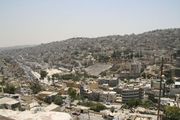

The Citadel hill of Amman, known as Jabal al-Qal'a, has been inhabited for centuries, important as a military and religious site. It dates back to Roman and Byzantine times, and later work was carried out in the early Islamic era. Remains unearthed at the northern and eastern ends of the Citadel, possibly date back to the Bronze Age. The Citadel also is home to the Temple of Hercules which is said to have been constructed under the Roman Emperor Marcus Aurelius who reigned from 161-180 AD, is similar to the Temple of Artemis in Ephesus.
Since Amman resembles Rome, as it is situated on seven hills, the city was a favorite place for Roman soldiers and officials. Behind the Roman forum stands a Roman theatre — the largest theatre in Jordan — with room for 6,000 spectators. Thought to have been built between 138 and 161 AD by the Roman Emperor Antoninus Pius, it is constructed into the side of the mountain and is still used for sports displays and cultural events.
Amman is also home to some of the grandest mosques in the Middle East, although they compare less favorably to the ones to be found in Istanbul, Turkey. The newest of these is the enormous King Abdullah I Mosque, built between 1982 and 1989. It is capped by a magnificent blue mosaic dome beneath which 3,000 Muslims may offer prayer. The most unusual mosque in Amman is the Abu Darweesh Mosque atop Jabal Ashrafieh (the highest point in the city). It is covered with an extraordinary black and white checkered pattern and is unique to Jordan. It is striking and visible from quite some distance. In contrast, the interior is totally free of the black and white scheme. Instead, there are light colored walls and Persian carpets. This religious building was erected by one of Amman's Circassians minority.
Amman is also home to many jewelers and souvenir shops for citizens and tourists alike. Amman is also a major destination for foreign students seeking study in Arabic. Amman's world-class hospitals are frequent destinations for those who seek medical treatment.
The city’s culinary scene has expanded from its famous shwarma stands and falafel joints to embrace many popular Western restaurants and fast-food outlets like McDonald's and TGIF, a host of swank Asian fusion restaurants, intimate French bistros such as La Maison Verte and authentic Italian trattorias.[9]
There are numerous nightclubs and bars across the city especially in West Amman. Modesty in dress for men and women go out the window and low-cut shirts, tank tops and short-skirts are common.[10] Although Amman has a rapidly growing nightlife scene, Beirut and Tel Aviv still are the two nightlife hubs of the Middle East. However, Amman is mounting a challenge to Beirut as the Arab style capital with a plethora of retail outlets and malls currently operational and more on its way. Amman's nightclubs are filled with young Jordanians, Persian Gulf vacationers, American soldiers and businessmen on their way to Iraq. Abdoun Circle (not one of the eight) is the heart of the city’s thriving night life where the chicest clubs maintain a strict “couples only” policy, meaning no unescorted men. The night-life scene evolves so quickly that hot spots open and close almost before they can be published in magazines and tourist guide books.[9]
As well as the wide range of drinking and dancing venues on the social circuit of the city's affluent crowd, Amman has a surprising amount of cultural entertainment to indulge in like the annual Amman Summer Festival and Souk Jara.[11]
A new construction project in Abdali will transform downtown Amman into a more desirable place for investment. Valued at more than US $5 Billion, the Abdali project is expected to start welcoming visitors by 2010. Once completed, it will create a new visible centre for Amman and act as the major business district for this ever-thriving city. Amman’s new downtown that Abdali Psc is creating will cater to the needs of thousands of Jordanians and foreigners who choose Jordan as their living and investment destination. The core of the first phase will be completed in 2010, and phase one's high rise projects will be completed in 2011 and 2012. The second phase will be completed in 2014 and the entire project will be finished by 2015.[12]
Amman is an emerging hub for Persian Gulf vacationers who come to take advantage of the mild weather and liberal atmosphere during the summer. Over a million visitors from the affluent Persian Gulf stay in Amman for the summer annually. The summer of 2009 brought approximately 2.5 million Arab visitors to Jordan, mainly from the Persian Gulf.
700,000 vehicles arrive in Jordan every summer clogging up Jordanian highways and streets, especially in Amman. Persian Gulf vacationers, Jordanian expatriates, and regional tourists arrive in Jordan by car every summer to escape the hot summers common in the Persian Gulf and to enjoy a more moderate climate.
Unfortunately, a lone deranged gunman attacked Western tourists during a guided trip to the downtown Roman theatre in September 2006, shooting five of them, one fatally. The man was immediately apprehended, and claimed to have acted in response to the fighting between Israel and Lebanon during the prior months. Despite this attack, tourism in Amman continues on a daily basis, and the city's tourist locations are generally well-policed. Given Jordan's location in a region that sees frequent conflict and violence, by statistics and by general mood, Amman remains a safe and interesting place to visit. For example, despite this killing, there is little or no violent or petty crime in Amman, especially against visitors, who uniformly report feeling safe at all hours in practically all locations in the city.
Shopping
Shopping is continually becoming more popular in Jordanian culture and is very notable in the past five years, with huge mega malls popping up across Amman such as Mecca Mall, Abdoun Mall, Amman Mall, City Mall, Plaza Mall, and Al Baraka Mall. Furthermore, two new malls are currently under development: Taj Mall in the affluent neighbourhood Abdoun and Abdali Mall in Al Abdali. The Wakalat Street (English: Agencies Street) is Amman's first pedestrian-only street and carries a lot of label name clothes. It is one Amman's most vibrant shopping districts.
Nearby places of interest
Amman is conveniently located for many Jordanian attractions favoured by tourists. It is a mere 45 minute trip by car to several interesting locations:
- The Baptism Site (Al-Maghtas in Arabic) on the Jordan River where Jesus Christ was baptized by John the Baptist
- Mount Nebo where, according to the Bible, Moses died
- The unique ultra saline waters of the Dead Sea, home to many first-rate resorts
- Jerash, a city of the Decapolis and considered one of the most important and best preserved Roman cities in the Near East
- The Hellenistic ruin of Qasr al Abd, in the near-by valley of Wadi Al Seer
- Petra, two hours from Aqaba, is one of the most breathtaking places in the world (one of the 7 wonders of the world)
- The beaches at Aqaba, a shipping port and Jordan's only access to the Red Sea. Just about three of four hours from Amman by car or 350 km (220 mi) away. You can also take a plane on Royal Jordanian from Queen Alia Airport to King Hussein International Airport (Aqaba Airport). The primarily industrial character of the town is mitigated by the fact that it is set between sprawling mountain ranges and boasts some of the finest coral reefs in the region.
- The unique geological rock formations of Wadi Rum. The colorful rocks are best viewed at sunset and located a half hour away from Petra. Wadi Rum has connections with T. E. Lawrence; consequently the movie Lawrence of Arabia filmed there for a number of scenes.
- Iraq Al Amir :Iraq Al Amir is situated in a lush, secluded wadi 24 km to the southwest of Amman. The area is generally known for Qasr Al-Abd (palace of the Slave), an impressive and unique building which dates from the first quarter of the 2nd century BC. Originally two stories high and constructed of megalithic stones weighing from 15-25 tons each, it is the most striking Hellenistic monument that has survived on either side of the Jordan River
Picture gallery
 The Le royal hotel at night |
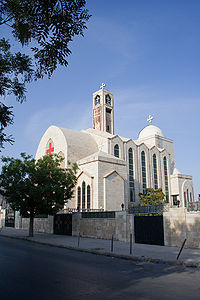 A Coptic Church is an example of Amman's religious diversity |
 An overview of East Amman. |
 Snow in Amman. |
 A view from Amman's Regency Hotel |
Inside of King Abdullah I Mosque |
 Jordan Gate Towers under construction |
Temple of Hercules on the top of the catidal hill |
|
View over Amman from National Orthodox School |
Le Royal |
Zara Towers |
Zahran Street, featuring one of the recently put up street name signs |
 Another construction picture of Amman Gate Towers |
 Construction picture of Gate Towers from the street |
First round about |
Second round about |
|
Third Roundabout - Jabal Amman |
International relations
Twin towns — sister cities
|
See also
- List of tallest buildings in Amman
References
Notes
- ↑ "Jordan Department of Statistics". Dos.gov.jo. http://www.dos.gov.jo/. Retrieved 2010-07-04.
- ↑ "DoS Jordan". Dos.gov.jo. http://www.dos.gov.jo/home_e.htm. Retrieved 2010-07-04.
- ↑ Business Optimization Consultants B.O.C.. "Jordan - Touristic Sites - Amman". Kinghussein.gov.jo. http://www.kinghussein.gov.jo/tourism1.html#History. Retrieved 2010-07-04.
- ↑ "Jordan Meteorological Department". Jordan Meteorological Department. http://met.jometeo.gov.jo/portal/page?_pageid=113,1,113_56214:113_82177&_dad=portal&_schema=PORTAL. Retrieved February 27, 2008.
- ↑ Greater Amman Municipality Website
- ↑ "Royal Jordanian". oneworld. http://www.oneworld.com/ow/member-airlines/royal-jordanian. Retrieved 2010-07-04.
- ↑ "Company Overview." Royal Jordanian. Retrieved on 30 May 2009.
- ↑ "The Abdali Boulevard". Abdali-boulevard.jo. http://www.abdali-boulevard.jo/. Retrieved 2010-07-04.
- ↑ 9.0 9.1 Ferren, Andrew (2009-11-22). "A Newly Stylish Amman Asserts Itself". The New York Times. http://travel.nytimes.com/2009/11/22/travel/22next.html?pagewanted=1. Retrieved 2010-03-30.
- ↑ "Jordan Guide – Rough Guides travel information". Roughguides.com. http://www.roughguides.com/website/travel/destination/content/default.aspx?titleid=87&xid=idh540853136_0151. Retrieved 2010-07-04.
- ↑ "Jordan Guide – Rough Guides travel information". Roughguides.com. http://www.roughguides.com/website/travel/destination/content/default.aspx?titleid=87&xid=idh340849616_0151. Retrieved 2010-07-04.
- ↑ "Abdali". Abdali.jo. http://www.abdali.jo/overview.php. Retrieved 2010-07-04.
- ↑ "Amman’s Relations with Other Cities". http://www.ammancity.gov.jo/english/relations/r12.asp.
- ↑ "Sister Cities". Beijing Municipal Government. http://www.ebeijing.gov.cn/Sister_Cities/Sister_City/. Retrieved 2009-06-23.
- ↑ Prefeitura.Sp - Descentralized Cooperation
- ↑ "International Relations - São Paulo City Hall - Official Sister Cities". Prefeitura.sp.gov.br. http://www.prefeitura.sp.gov.br/cidade/secretarias/relacoes_internacionais/cidadesirmas/index.php?p=1066. Retrieved 2010-07-04.
- ↑ "Milano - Città Gemellate". © 2008 Municipality of Milan (Comune di Milano). http://www.comune.milano.it/portale/wps/portal/CDM?WCM_GLOBAL_CONTEXT=/wps/wcm/connect/ContentLibrary/In%20Comune/In%20Comune/Citt%20Gemellate. Retrieved 2009-07-17.
- ↑ "Sarajevo Official Web Site : Sister cities". Sarajevo.ba. http://www.sarajevo.ba/en/stream.php?kat=160. Retrieved 2009-05-06.
External links
- Amman travel guide from Wikitravel
- Amman City Guide
- 360 degrees panorama from the Citadel Hill in central Amman
- Amman interactive map
- Amman Discussion Forum (Arabic)
- Amman photo Gallery
- Amman photo Slideshow
- WikiTravel WikiTravel - Petra
- Website for Amman's centennial celebrations telling the modern history of the city
|
||||||||
|
|||||
